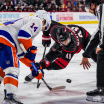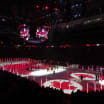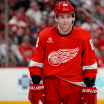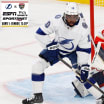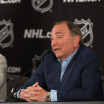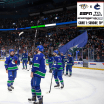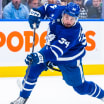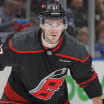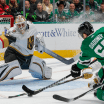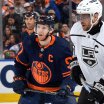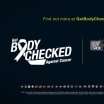ANAHEIM --Throughout most of the past decade, the Anaheim Ducks relied on a tried-and-true formula for success: Getzlaf to Perry.
During this span, much of Anaheim's offense came from the same play. Ryan Getzlaf, the dynamic playmaking center, would find his longtime linemate Corey Perry cutting up the wing. Perry, using the strength of his wrists and his deft scoring touch, would put the puck in the net. It became as routine as tying up skate laces.
For Ducks, absence leads to success
Splitting of Getzlaf, Perry fuels Anaheim run
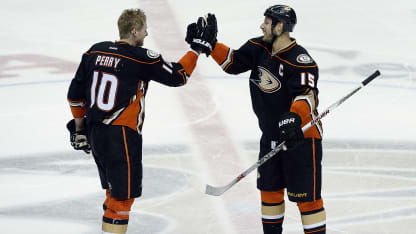
© Kevork Djansezian/Getty Images
By
Abbey Mastracco / NHL.com Correspondent
Drafted nine spots away from one another in 2003, the two were put on a line with one another in the minor leagues and instantly became such a dynamic duo that they were never split up. They won the Stanley Cup and two Olympic gold medals as linemates.
Since 2007-08, either Getzlaf or Perry has led the Ducks in scoring in every season and the other has finished second -- except for 2011-12 when they finished second and fourth.
But then the Ducks, who came a game away from a trip to the Stanley Cup Final last season, opened up this season flat, unable to generate any offense.
They scored the fewest amount of goals in the first half of the season and quickly fell to last place in the Pacific Division. So coach Bruce Boudreau did what once seemed unthinkable: He split up "The Twins."
"If it works, you don't really want to break it up," Perry said. "But at some point, it's not a bad thing to do it. It's really worked here."
Splitting up Getzlaf and Perry appears to have solved a world of problems. It has created depth, allowed other players to emerge and for roles to be solidified. What was once the most glaring weakness, the power play, has become a strength, as Anaheim has scored a power-play goal in each of game of their franchise record-breaking 11-game win streak.
Anaheim goes for win No. 12 in the streak Monday against the League-leading Washington Capitals (10 p.m. ET; SNE, SNO, CSN-DC, PRIME, FS-SD, NHL.TV) at Honda Center.
The Ducks sit in first place in the Pacific with a 37-19-8 record. Their 82 points are good for fourth-best in the Western Conference and sixth-best in the League. They are 22-4-2 since Jan. 1.
"One of the lines is going to go up against the second or third [defense] pairing because you can't play the first pairing against both lines," Perry said. "That causes probably a little havoc on both teams. It's helped our team, I think. It's rounded out our scoring and put pressure on all of the lines to score and defend the way we can. I think it's working out right now."
The Ducks now consistently roll two solid scoring lines, a shutdown checking line and an energy line in a deployment few teams have been able to match.
"It feels like every line is playing in the O-zone for the most part of the game, and then it's tough for anyone else to generate any offense because they're tired," said David Perron, Getzlaf's new linemate. "The first 20-25 seconds of their shift they have to defend and then the other 15-20 seconds they're too tired to try and score goals."
Perron came to Anaheim on Jan. 16, shortly after the Ducks' turnaround began, in a swap that saw one struggling left wing traded for another. Carl Hagelin, the Ducks' prized offseason acquisition, was sent to the Pittsburgh Penguins in return for Perron and defenseman Adam Clendening, in a late-night move that happened mere hours after a win against the Dallas Stars.
The move seemed puzzling, as the team was finally playing well and Perron had been struggling in Pittsburgh (four goals, 12 assists, minus-13 in 43 games). But Anaheim general manager Bob Murray was confident Perron could regain his offensive prowess with a change of scenery.
Perron scored eight points during his first six games in Anaheim. He's scored eight goals in 21 games with Anaheim and has a plus-14 rating.
"I didn't expect his plus/minus to be 14 in the time that he came over," Boudreau said. "[San Diego Gulls coach] Dallas Eakins phoned me when we made the trade, because he had him in Edmonton, and he said, 'You're getting a very skilled, skilled hockey player.' That's what we've got. He gets his shot away really quickly, he's got a great release."
Playing with Getzlaf doesn't hurt, either.
"He works hard, he's strong on the puck in their zone and that's the biggest thing for me in finding linemates," Getzlaf said. "If you can hang around the puck and spend more time down there, it's better for our game."
Meanwhile, Perry has developed obvious chemistry with second-line center Rickard Rakell. In a breakout season, Rakell has proved himself as a tenacious player with playmaking ability.
"It kind of reminds me of when [Getzlaf] and I started coming up and we just clicked right away," Perry said. "When I played with [Rakell] in the preseason, I thought, 'There's going to be something there.' And then I went back with [Getzlaf] and [Rakell] came up to our line and that worked great. I think with [Rakell's] skating and passing ability and with the vision he has, just the hockey IQ he has, he's a player that can be one of the top centers on a team and go out and do the right things."
With the exception of Henrik Sedin and Daniel Sedin of the Vancouver Canucks, Perry said there might not be another tandem in the League more comfortable with one another than he and Getzlaf were.
Maybe too comfortable, Boudreau said.
The introduction of new linemates has forced each player outside of his comfort zone on the ice.
"The one thing with Corey and Ryan is that they're always looking for each other. With Rakell, he's looking for whoever is open. Consequently, Corey is working harder to get into the right spots," Boudreau said. "You can look at our resurgence, and, quite frankly, it's coincided with Getzlaf's resurgence."
There's been a few times in the past where Getzlaf and Perry have been forced to play apart. Getzlaf was out with injuries for much of the 2010-2011 season when Perry won the Hart Trophy. Last year, Perry was out for a significant amount of time with the mumps and a knee injury.
They used to joke they made each other better; now it might be that they're better off apart.
"I don't know if one coincided with the other, but I do know that when we put Rakell and Perry together and Perron and Getzlaf together, it's a tougher team to play against because of the defense corps," Boudreau said. "Your top two can only be out against two of them or three of them. That made us a better team. The fact that we had success made it easier to keep it that way."
